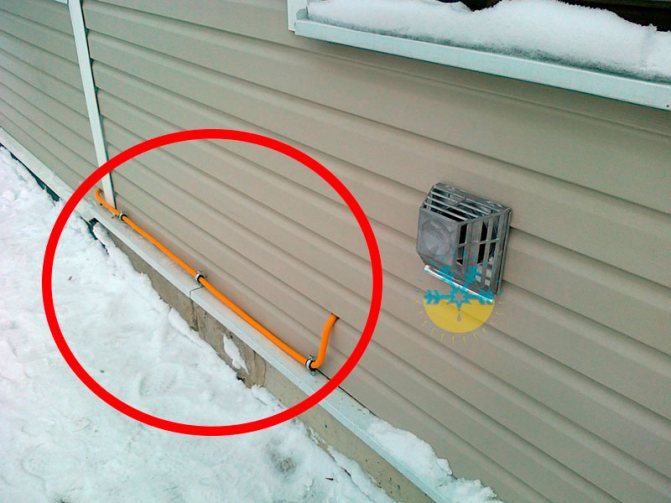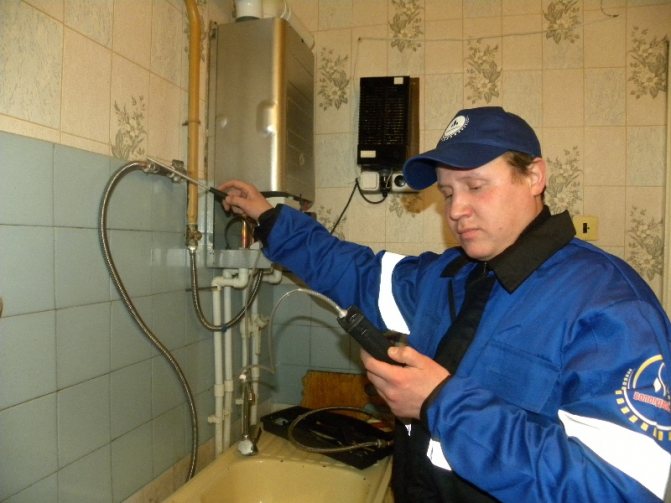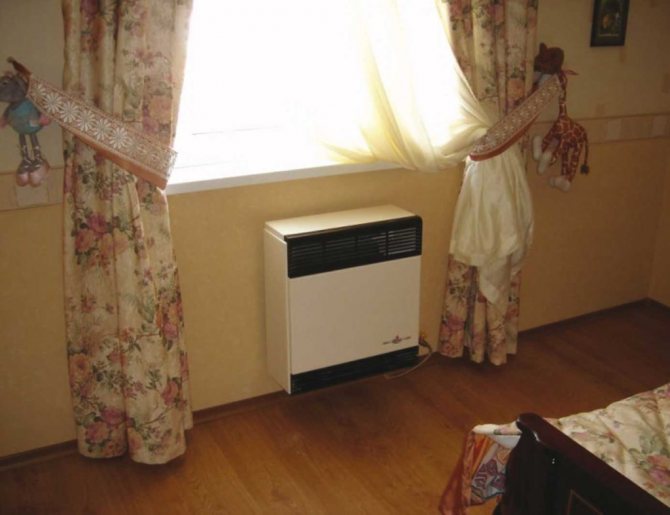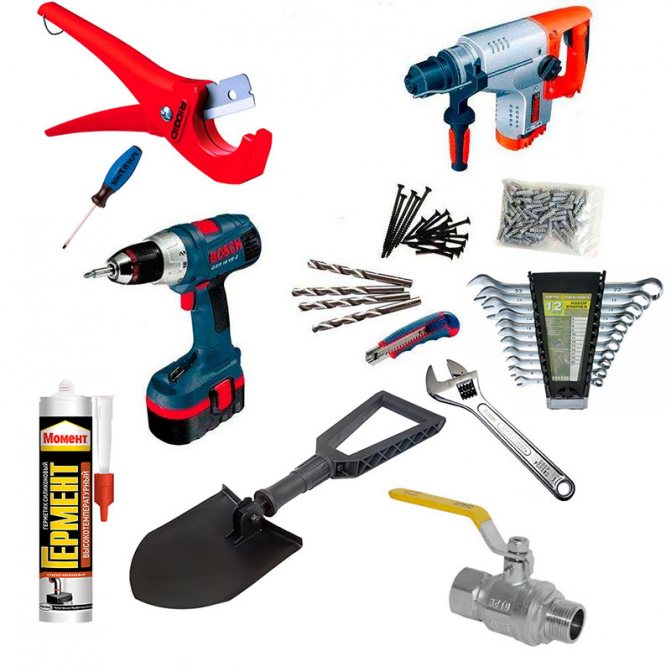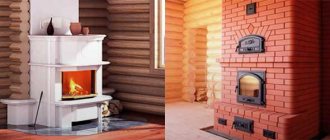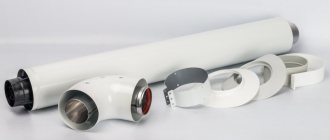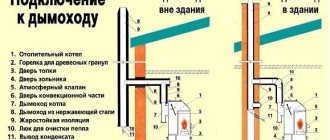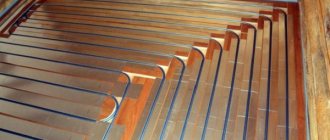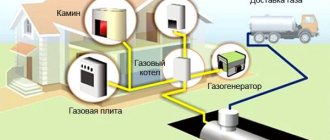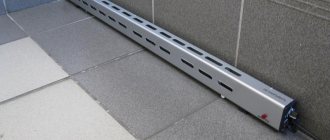Features of use
First of all, people are concerned about the issue of safety, because wood is a rapidly flammable material, which means that when installing such equipment there are risks of fire, and the coefficient of positive action of gas converters leaves much to be desired.
On the other hand, the installation process is much simpler than batteries filled with hot water, for the supply of which you will have to install a cumbersome heating system.
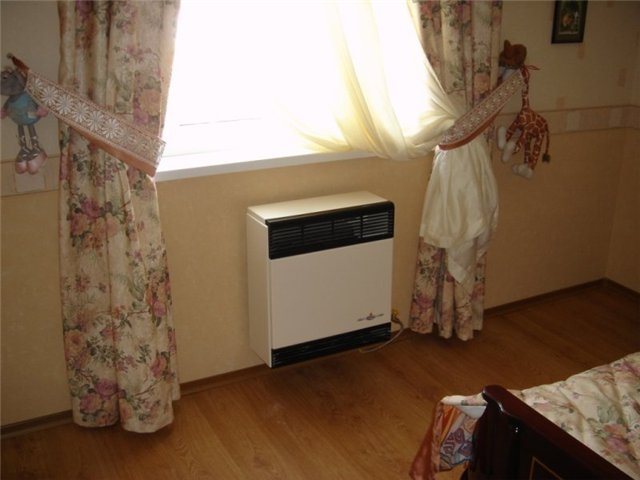
It is not uncommon for the original project of a wooden house to provide no heating at all, but during the operation the owner changed his mind, and the installation of heating devices is required after the fact. Many gas convectors may well satisfy such needs, because they are able to operate on gas supplied from a cylinder, and not from the mains.
In order to obtain permission to install a gas convector in a wooden house, you need to make a visit to the gas or fire department, depending on the gas source, but first things first.
Convector test run
After carrying out all the above measures, a test run of the gas convector is carried out. It is performed according to the instructions supplied with the installed equipment.
The gas pipeline is connected to the convector using a special type of flexible hose. The unit is energized. The “Start” command is given from the remote control. This ignites the burner and turns on the built-in fans.
At the initial stage, the operation of the equipment may be accompanied by extraneous odors. This is most often caused by the fading of excess paint and lubricants in areas close to hot surfaces.
The stability of the installation is monitored. When working, there should be no smell of gas, smoke, extraneous sounds. The direction of air supply is adjusted, the temperature regime is set.
The advantage of gas convectors is that there is no need to build a heating system, there is no water in the equipment. This protects against the occurrence of leaks and the cost of installing piping with heating devices. The main disadvantage is the length of time required to arrange the installation of gas convectors, the presence of hot surfaces and the possibility of natural gas leakage.
Installing a gas convector in a wooden house has both pros and cons.
Requirements for the premises
Requirements of gas services for premises:
- The ceilings should be at least two and a half meters, which is important, because many wooden houses are built with low ceilings, and this is with the least-powerful equipment;
- The ventilation duct in diameter must be equal to or exceed 100 mm, the material from which it is made must comply with SNIP, and the lower part of the ventilation duct must be at least 200 mm below the ceiling;
- Bottom gaps on interior doors must be at least 25 mm;
- Each room should have windows allowing to ventilate the room;
- The boiler room should be equipped with a door to the adjacent non-residential premises, and when installing a boiler with a capacity of more than 150 kW, a separate entrance door;
- The internal space of the boiler room must have at least 7.5 m3 in volume, for new houses this requirement has been doubled;
- Chimney - must be equipped with two walls, its diameter must be greater than or equal to the incoming pipe of the equipment;
- Lighting in the boiler room must be safe; for this, open bulbs without shades are not allowed;
- In the case of external wiring, it must be placed in specialized cable channels;
- The internal gas control system should be installed in a wooden house if the boiler is in the basement.
Scope of application of the chimney convector
There are three types of convectors: water, electric and gas. The installation of a chimney-convector is required only on gas heating systems and sauna stoves.
Chimneys-convectors are successfully used for an accelerated heating rate of adjacent rooms, which is carried out by taking heat fluxes from gases escaping through the smoke. In addition, they serve as a protective mechanism against infrared radiation that emanates from the chimney. They are easy to install. They are also easy to operate. If the design is simple and without a fan, then the presence of electrical wiring is not required.
The chimney convector can be installed in two ways:
- connecting the pipe to a common chimney;
- arrangement of our own smoke evacuation system.
Advice! The second method will allow you to heat two rooms at the same time. For example, a convector is installed in one room, and a chimney is installed in another. This system is ideal for a sauna with a relaxation room.
Installation of a gas stove and convectors
It is forbidden to install the convector at a distance of less than 4 meters from open sources of fire, including a gas stove. The hose suitable for the convector must have a dielectric insert, this will prevent a fire in the event of a short circuit in the wiring in a wooden house.
An important factor is the grounding of sockets located near the gas stove and convectors, although in a house made of wood they must be grounded a priori.
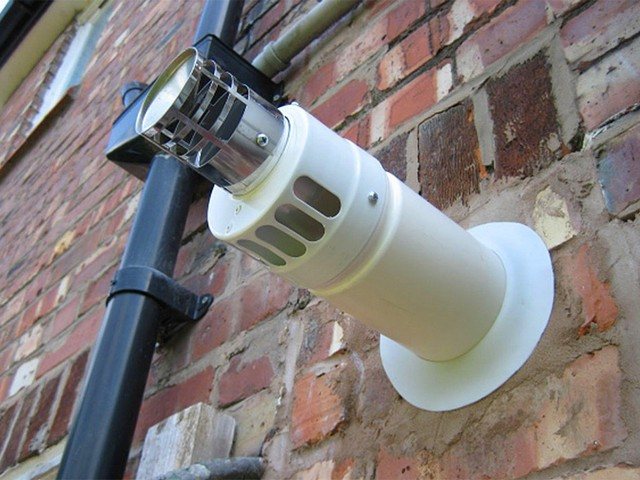

There are three types of hose connections that are allowed to the gas stove in a wooden house, namely:
- Rubber-fabric - its plus is that it does not conduct electric current, but it is more susceptible to mechanical damage compared to analogues;
- Metal sleeve - when using it, a dielectric insert from the gas stove to the main is necessarily inserted, but otherwise it has the best performance among analogues. In addition, it is recommended by the latest approved standards. Its only drawback is the price, it bites;
- Rubber with metal braid - it is more capable of withstanding serious shocks, and also does not conduct current thanks to the rubber core.
When buying a hose, pay attention to the colors; there are characteristic yellow colors on its braid, which are used only for marking gas equipment.
When buying a metal sleeve, you should pay attention to its coating; some manufacturers targeting other markets, with other regulations, use yellow insulation, which does not fulfill its main functions. Always ask for shipping documents and keep them in a safe place.
Do-it-yourself converter chimney
Gas converter chimneys have a simple device, they can be made by hand.
At its core, the convector is a large-diameter pipe with welded-on pockets, which can be made of pipes of a smaller diameter, rectangular metal profile or metal plates.
Metal chimney converter
Making a chimney-converter from iron is within the power of those who know how to use a welding machine.
Step-by-step instruction:
- Step 1. You should take a pipe with a diameter similar to that of the one that comes out of the stove (usually it is at least 15 centimeters), and cut it in relation to the length of the chimney. On average, it is 55 centimeters.
- Step 2. You need to take a pipe with a diameter of 5-7 centimeters and cut it into 6 pieces, 45 centimeters in size.
- Step 3.Weld 6-8 resulting blanks to the main one. They should form a complete circle around it.
- Step 4. The chimney convector is ready.
- Step 5. You should connect it to the pipes.
Advice! After the converter is ready, for better heating, it should be painted black, and for an aesthetic look, it can be closed with some interesting plate made of metal or galvanized sheet.
The main advantages of gas convectors for wooden houses
All the complex nuances that needed to be understood were sorted out before choosing this equipment, it remains to list advantages of gas convectors for wooden houses:
- Efficiency - if a wooden house is assembled in accordance with the rules and does not have shrinkage crevices, then a very small amount of gas will be required to heat it;
- The smallest boiler allows you to heat a room with a total area of up to 350 m3, and this is the size of a huge house, but subject to ceilings at 2.5 meters;
- There are double-circuit boilers that will supply your house made of wood not only with heat, but also with hot water, the price for them is slightly higher, but there are pluses on the face;
- Both automatic and manual ignition can be used to supply heat to the convector;
- Provided that the ventilation standards are met, the natural outflow of gas is easy, and the danger of their accumulation is not observed.
Heating installation options
According to the requirements of gas and fire safety, the boiler room is provided with a chimney and an exhaust hood. This is if the owner of the house has decided to install gas heating with his own hands. Even when specialists are required to work, fire and gas safety requirements must be observed.
If the combustion chamber of a gas boiler is of an open type, then the chimney must be thick and large in size, located vertically. If the combustion chamber is closed, then there is no need for a large chimney. In this case, a special thrust is installed to transfer combustion waste into a pipe with a diameter of 10 centimeters. As with a system with an open combustion chamber, ventilation of the room is not required here, since air will enter the burner from the outside.
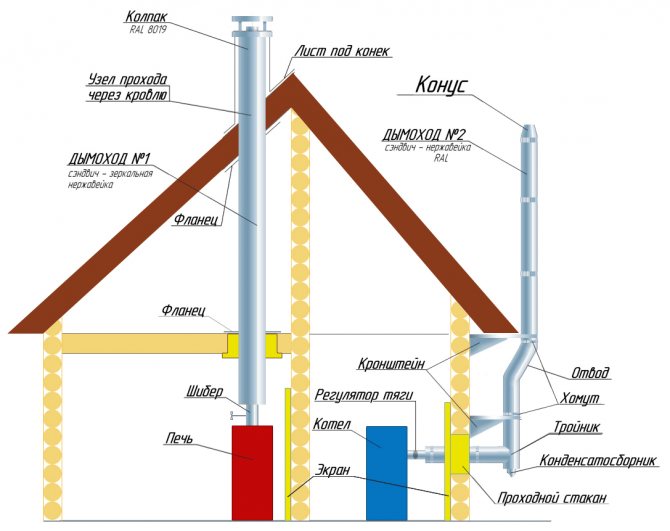

Chimney design
Wooden walls of the house do not allow the installation of channels from the inside Instead, a metal chimney is most often used, with insulation from the inside. They are also called sandwiches. Such chimneys are directed directly outward, rushing up the outer wall. This has many advantages, but operational problems are possible.
In severe frosts, chimneys with internal insulation will not cope with their functions. The cooled air in the pipe goes down, plugging the passage, creates a draft in the opposite direction. As a result, the gas water heater stops working, or works in emergency mode, and the boiler room cools down. Therefore, when using "sandwiches" should take into account the weather conditions of the area. If frosts are possible, then the installation of "sandwiches" must be done from the heated side of the house, only a small part of the pipe goes to the roof.
In connection with the idea of using various chimneys, it is necessary that the walls inside the device be plastered.
The process of installing a gas convector in a wooden house
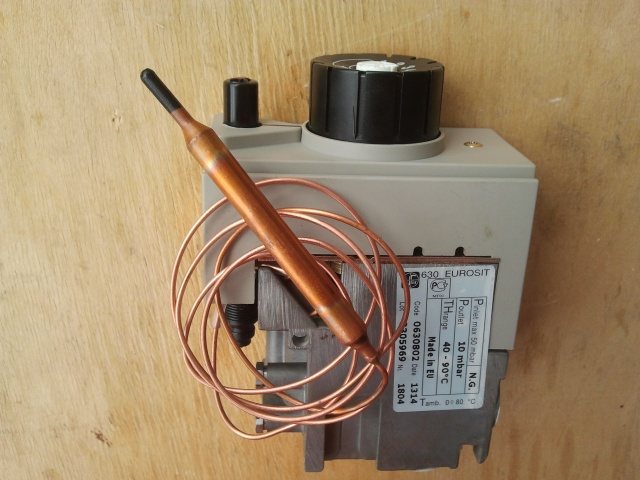

There is nothing easier than fixing the converter to a wooden wall, for this you will need:
- Self-tapping screws;
- Crosshead screwdriver;
- Mounts (included with the converter);
- Building level;
- Pencil.
To begin with, you should check how far from each other are the loops for which the gas convector is hung. Most often they are wide enough, which allows you to move it to the left and right on the mountings, at a distance of about 5 cm.
Measure the distance between the centers of the seats, for the upper and lower loops it will be the same.Transfer these dimensions to the wall, observing the height you need from the floor, most often it ranges from 10 to 20 cm.
The self-tapping screws used must be at least 40 mm long, this will ensure reliable fixation to the wall in a wooden house.
Attach self-tapping screws to the designated points, and double-check with the help of a convector whether the distances coincide by bringing it to the caps of the self-tapping screws. If so, then you can safely fix the hooks to the wooden wall.
When the fasteners are screwed in, place a level on them and check the slope relative to the horizon, it can be leveled by loosening one of the fasteners and lifting it slightly. Now you can hang the gas convector on the wooden wall.
The main stages of work
Here are all the elements you need for a quality installation. Now you should go directly to the installation of gas convectors. The principle of operation is quite simple, you just need to follow the instructions.
- You need to choose a place where the device will be located. Most regulations indicate that it can be installed under a window.
- Having chosen a convenient location, it is necessary to try on the gas convector itself in place. Here, the principle of operation is that you can not carry the entire apparatus, but simply use a tape measure, initially taking the necessary measurements. But you can attach the gas convector to the wall in order to outline future mounting holes.
- The third step is to install the gas inlet. If it will be located in the lower part of the convector, then it is necessary to leave a sufficient distance for the supply of the pipe with a clamping fitting at the end.
- Further, a through hole in the wall is punched through the diameter of the exhaust pipe using a perforator. Installation at this stage of work is considered the most laborious, so you should prepare in advance for dusting the room. Cover everything with plastic wrap or rags.
- Drill holes for fasteners, drive dowels into them.
- Now it is necessary to insert a chimney into the device. The joint is treated with silicone, which can withstand high temperatures. Hold the convector on your hands, push the pipe into the hole in the wall. Now the gas convector can be fixed on the wall plugs using self-tapping screws. Installation requires special attention during these stages. This is due to the fact that the convector is heavy. If everything works out correctly, then the indicated principle of operation will help you to attach the convector to the wall and bring the outlet pipe out into the street.
- Now properly seal all the gaps between the pipe and the wall using high temperature foam.
- Install a special cap on the end of the pipe, which is included with the purchase. This hood will serve to prevent strong wind gusts from blowing out the burner. The cap is installed on self-tapping screws included in the kit.
Back to the table of contents
Gas supply to the convector
Close the gas valve in front of the meter.
This process requires special attention, in any room, and even more so when it comes to a wooden house. The main thing here is to check whether all the elements of the gas supply correspond to the description of the accompanying documentation.
Ball valves with yellow handle markings are screwed onto the convector. Until the moment of start-up, they must be in a closed state. It is necessary to screw a hose or a sleeve to the gas cylinder or the main line, be sure to check for the presence of a paranite gasket in the union nut of the hose.
The next step is to connect the other end of the hose to the tap installed on the gas convector. Here you should also check if there is a gasket. After that, you need to compress all connections using spanner keys.
Calculate the force, it is important not to crush the gaskets, otherwise the gas will pass through the damaged parts of the system.
Now you can open the gas and the taps on the convector. Using a shaving brush, apply the foam solution to all joints.After making sure that there are no leaks, you can proceed to the first start.
The first start-up in a wooden house is made with the windows open for ventilation.
Gas supply: main stages
The gas convector has been installed, now you need to deal with the gas supply. This stage is quite difficult and responsible at the same time. To supply gas, do the following:
- According to regulatory documents, the pipe suitable for the convector must go down the street. There are two options here: the first - the pipe has a pre-drawn threaded connection, the second - there is no such connection. If there is a thread, then you can screw on the gas valve yourself, which will cut off the gas supply to the convector. In the absence of a tap, it must be done. To do this, call professional gas welders from the local Gorgaz or a similar office.
- After installing the gas valve, it is necessary to lead the metal-plastic pipe to the convector itself. Using a tape measure, calculate the length of the pipe, along the way determining the presence of fittings.
- You need to buy pipe and fittings. The principle of the purchase is that the seller must check the availability of a certificate of conformity of these pipes and fittings to this type of work.
- Lay the pipe, fix it with clips every m. To install the clips, you need to drill holes in the wall.
- When installing the required fittings, carefully lubricate the pipe and the fitting itself with silicone to provide additional sealing. The silicone will also serve as a lubricant and facilitate pipe installation.
As a result of the work, you should get a convector mounted on the wall with a gas pipe connected to it.
Now the last step of the installation remains. A test run is required.
Before starting, open the gas valve and brush over all fittings and threaded connections with a brush dampened with a solution of soap or shampoo. This will allow you to spot inflated bubbles (if any) that indicate gas leaks. If this happens, immediately close the gas supply valve. After checking the joints, start the convector. To do this, hold down the gas supply button for one minute. This will allow the gas to pass through the pipes and enter the combustion chamber. Press the piezo igniter, the spark should ignite the gas. A blue flame will burst into the furnace.
Adjust the convector to a comfortable temperature. During the first few hours of operation, you may smell an unpleasant smell of burning oil. This is normal, as the convector is new and the combustion chamber burns out. If the smell lingers for a long time, then it is worth turning off the gas and re-checking all joints and threaded connections.
It is advisable that all work on the installation of gas convectors is carried out by a professional who has sufficient experience in performing such work. This is also due to the fact that self-installation of the convector may void your warranty on the device. The gas convector must be accepted on the balance sheet by Gorgaz.
You must have documented tie-in permission on hand. In addition, all decisions on the installation, as well as the conclusions of the commission for the acceptance of the device into operation must be documented and signed in the proper way.
D. Sytov
From a technical point of view, a gas convector is a fairly simple device. Accordingly, its installation may seem like a simple matter. However, there are a number of rules and nuances, neglect of which can lead to incorrect operation of the device or even to an accident. Consider the basic rules for installing a gas convector
Installation of a gas convector is regulated by the following documents: DBN V.2.5-20-2001 "Gas supply"; DNAP 0.00-1.20-98 "Rules for the safety of gas supply systems in Ukraine"; A. NAPB 01.001-2004 "Rules of fire safety of Ukraine".
Wall hung gas boiler
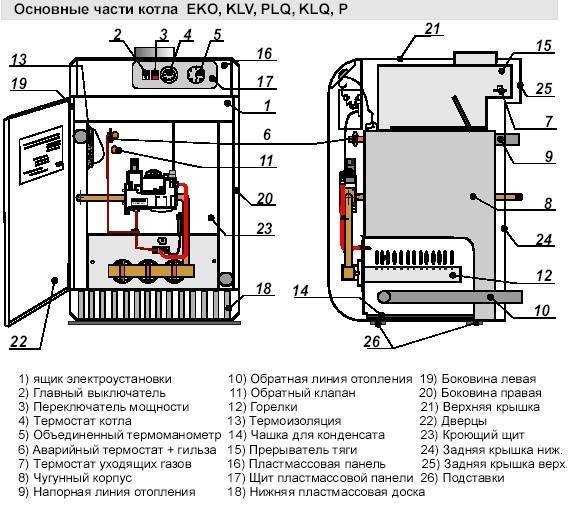

Diagram of a wall-mounted gas boiler.
Heating with a wall-mounted gas boiler is convenient due to its lightness and compactness. It should be installed on a load-bearing wall. The location of the mounting plate is carried out at a height of 1 to 1.6 m. For the removal of a coaxial chimney, it is better to use a detailed diagram. The diameter of the pipe must match the hole in the boiler. The independent connection of the boiler to the gas pipe is carried out using a rubber hose, but it is best to ask for help from the gas installation organizations.
After that, you should make sure that the connection is tight by applying soap solution to the threads of the joints of the connections.
Gas boiler heating is one of the most economical and environmentally friendly types of heating systems for wooden houses. The range of the heated area of one boiler reaches about 350 m². When choosing, it should be borne in mind that 1 kW is enough for every 10 m². Exist . General heating is installed using single-circuit boilers, while double-circuit boilers, in addition to this, solve the issue of hot water, heating from 60 to 200 liters of hot water. There are also 2 types of ignition: automatic and manual, triggered by a button. They are distinguished by natural and forced draft of boilers. If the exhaust gases are removed by the draft generated in the chimney, then this is a natural draft gas boiler. When the gases are removed by means of a built-in fan, this is a forced draft boiler.
When installing a gas boiler in a wooden house, any installation and installation must strictly comply with construction and technical rules and strictly follow safety requirements. Gas boiler control devices have automated functions. The housing contains burners, a heat exchanger, a pressure gauge, a security system, circulation pumps, a thermometer, and an expansion tank. It is quite possible to install a gas boiler on your own, without the services of heating systems firms. Everything that is connected with the installation of the device itself, the installation work of the pipes of the water supply system and the connection of the power supply, it is quite possible to perform with your own hands.
However, it is better to contact specialized organizations for gas supply. A gas heating boiler is the most common way of a general heating system today. Cheap organization, assembly and operation make it possible to make a choice in favor of purchasing and installing gas boilers for wooden houses.
The situation with a wooden house
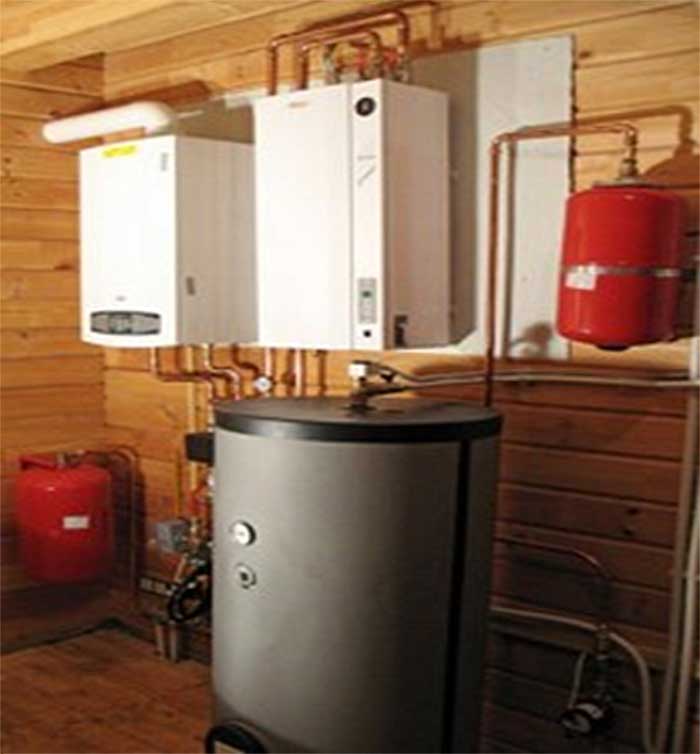

Installation of a gas convector in a wooden house and installation features are related to the fulfillment of the following criteria:
- Identify a suitable site for tube insertion. This is influenced by the type of convector for placement: on the wall or on the floor.
- Create a hole through the wall. It does not differ in diameter from the outlet pipe.
- At the third stage of installing the gas convector, dowels are attached to the wooden wall to fix the convector itself. Holes are created in the wall for these tasks. When installed on the floor, they are made in the floor.
- The device must be connected to the outlet pipe. The connection area is sealed with silicone.
- After installing the device, polyurethane foam is used to fill all existing voids.
Hinged gas boiler
Scheme of a hinged gas boiler.
Heating due to the hinged gas boiler stands out for its convenience, due to its lightness and small size. It must be mounted on the load-bearing wall. The installation of the mounting rail is carried out at a height of 1 meter square meter to 1.6 m. For the removal of a coaxial type chimney, it is better to use a detailed diagram. The pipe diameter must clearly correspond to the boiler hole. The independent connection of the boiler to the gas pipe is carried out using a rubber hose, but it is much better to ask for help from the gas installation organizations.
After that, you should make sure that the connection is tight by applying a soap-based solution to the threads of the joints of the connections.
Heating a gas boiler is considered one of the most economical and environmentally friendly types of heating systems for wooden houses. The range of the heated area of one boiler can reach about 350 m2
When selecting the power of a gas-fired boiler, it is necessary to take into account that for every 10 m2, 1 square meter of sq. KW is enough. There are double-circuit and single-circuit boilers
General heating is installed using single-circuit, while double-circuit. In addition to this, they must solve the issue of hot water, heating from 60 to 200 liters of hot water. There are also 2 types of ignition: automatic and manual, which can be switched on by means of a button. Allocate natural and forced draft of boilers. If the removal of exhaust gases is carried out due to the draft generated in the smoke exhauster, then this is a natural draft gas water heater. When the removal of gases is carried out using a built-in fan, then this is a forced draft boiler.
When installing a gas boiler in a wooden house, any installation and installation process must strictly comply with repair and technical rules and strictly follow safety needs. The control devices of the gas boiler have automatic functions. The housing contains burners, a heat exchanger, a device for determining the pressure value, a security system, circular pumps, a thermometer, and an expansion tank. The installation of a gas-fired boiler without outside help, without the services of heating systems companies, is quite possible. Everything related to the installation of the device itself, the installation work of the pipes of the water supply system and the connection of the electric power supply, it is quite possible to do it yourself.
However, it is better to contact special organizations for gas supply. A gas heating boiler is the most popular technique for a general heating system today. Inexpensive organization, installation and work make it possible to choose in favor of the purchase and installation of gas-fired boilers for wooden houses.
Gas water heaters for heating systems
More details on the website ust-stroy.ru
Installation criteria
For independent or custom-made work, the requirements for the installation of a gas convector must be observed:
- It is unacceptable to be placed in an apartment and in especially fire hazardous premises.
- Place the device only under a window or at a short distance from it.
- The pipe for the gas convector must run outside.
- The pipe must be equipped with a bend. As a rule, this is a job for a professional.
- After installation, a test run of the device must be carried out.
Floor Gas Boiler
The floor gas boiler is mounted either on a concrete base or on an aluminum sheet protruding at least 300 mm beyond the perimeter of the appliance. If this is a closed chamber combustion system, then a coaxial type chimney is used, the opening of which can be located both on the back wall of the device and on the top panel. The chimney must be placed away from the window so that there is no penetration of gases back into the room. The smoke exhauster pipe must have a slope to drain condensate due to the temperature difference. During the installation of vertical heating equipment, the hole for the smoke exhauster in the top panel must be at least 15 centimeters higher than the equipment itself. After the installation of the chimney is completed, you can turn on the water supply devices.
If it is necessary to determine a gas water heater for individual buildings, then the device must be placed in a specialized pocket, which has a depression of about 30 centimeters with a concrete screed and walls trimmed with fireproof materials.
Factors affecting the installation price
How much does it cost to install a gas convector in a house? Prices are due to the following factors:
- A manufacturer company.
- The parameters and type of a particular model: its power, quality
- The firm carrying out the work.
- Tools and equipment for work.
- The amount of work.
The scope of work may vary depending on the parameters of the premises and the goals of the customer.
So, if in a room of 30 square meters there are two or three windows, they mount one low-power apparatus under all the windows. This ensures thermal equilibrium here.
You can mount one unit, but more powerful, then there will be no balance. But this is the best option for a garage and other non-residential premises.
Average prices for installing gas convectors in a house are in the range of 5000 - 7000 rubles. Some companies offer discounts. But one way or another, specialized organizations must have licenses for these works.

